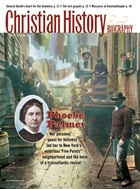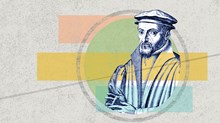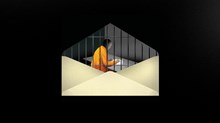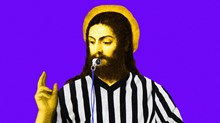In 1771, John Wesley received a remarkable letter from devout Methodist convert Mary Bosanquet (1739-1815). With her friends Sarah Crosby (1729-1804) and Sarah Ryan (1724-1768), Bosanquet had been running an orphanage and leading the small-group Methodist gatherings for spiritual growth that Wesley termed "class meetings." Crosby had in fact been speaking to groups sometimes numbering in the hundreds—though Wesley would not let her call her spiritual testimony "preaching." Bosanquet too had been leading class meetings, and been criticized for doing it.
She met the criticism head-on in her letter to Wesley: "Several object to this, saying 'A woman ought not to teach or take authority over a man.'" This might mean, Bosanquet allowed, that a woman should not take authority over her husband. But it emphatically did not mean that "she shall not entreat sinners to come to Jesus, nor say, come and I will tell you what God has done for my soul." Not every woman was called to be a preacher, no more than every man; but "some have an extraordinary call to it, and woe be to them if they obey it not."
That very month, June 1771, Wesley endorsed Bosanquet's friend Crosby as a lay preacher, using the phrase "extraordinary call." He gave his stamp of approval to Bosanquet as well. Both women became tireless evangelists, and some 41 women eventually became lay preachers in "Mr. Wesley's Methodism."
In 1781 Bosanquet married Wesley's intended successor John Fletcher. After Fletcher's death in 1785, Mary continued to hold preaching meetings and care for her late husband's Anglican parish, even appointing one of his successors. Despite the resolution passed in the Methodist Conference in 1803 (after Wesley's death) that women would not be allowed to preach, Bosanquet/Fletcher continued to preach five sermons a week until she died in her late 70s.
Coming to America
These were among the first women to find in Methodism a liberating power to preach the gospel, but they were not the last. A qualified openness to women as spiritual leaders carried over into American Methodism—brought to the colonies in the 1760s and a lay-led movement until Wesley ordained the first American preachers at the Methodist Episcopal Church's founding in 1784.
Barbara Heck, an early Irish Methodist émigré who encouraged her cousin Philip Embury to continue in America the lay preaching he had begun in England, earned from one Methodist historian the title "foundress" of American Methodism. As the story is sometimes told, Heck discovered a group of her fellow Irish immigrants playing cards. She swept the cards into the fire and marched to Philip's house, where she urged him to take up preaching again lest their friends and relatives "all go to hell!" Philip protested that he had neither a congregation nor a preaching house. "Preach in your own house and to your own company," said Barbara, and Methodism was born in New York.
In the 1800s, white and African-American women—including United Brethren prison chaplain Lydia Sexton (1799-1894) and African Methodist Episcopal evangelist Jarena Lee (b. 1783)—began to seek licensing to preach within the Methodist denominations.
Not all women preachers found this sanction necessary. For example, Phoebe Palmer never sought a license, though her ministry received tacit approval from the Methodist bishop and other clergy who attended her Tuesday Meetings.
"Well, God allows it"
Those who did obtain the church's imprimatur often stated that they would have continued without it. Maggie Newton Van Cott (1830-1914), the first woman licensed to preach in the Methodist Episcopal Church, began by obtaining an exhorter's license (exhorting differed from preaching in that the speaker did not "take a text" from the Bible to expound). When a critic protested that this license did not allow her to preach sermons, she replied, "Don't it? Well, God allows it. I received my commission from Him, brother."
Van Cott also famously commented to the pastor of the Duane Street (NY) M.E. Church, "I believe my tongue is my own, John, and I will use it when I please, where I please, and as I please." This she did as a traveling evangelist from 1866 to 1912. When she turned 50 in 1880, it was said that up to that point she had traveled 143,417 miles, held 9,933 revival meetings, and preached 4,294 sermons.
As Methodism and the holiness movement began to part ways, many holiness groups practiced in their earliest years an openness to the ministry of women that the more theologically liberal mainline denomination frequently lacked. Most Wesleyan/Holiness denominations gave licenses to and ordained women and men alike, although the women often faced more opposition and were given more difficult pastoral assignments.
Female traveling evangelists were also common, though not uncontroversial, in holiness circles. Among the most famous was the African Methodist Episcopal preacher, singer, missionary, and orphans' home founder Amanda Berry Smith (1837-1915). Unlike her earlier A.M.E. preaching colleague Jarena Lee, Smith ministered largely in white contexts, and she later became instrumental in the work of Frances Willard's Women's Christian Temperance Union (WCTU).
Smith had endured two unhappy marriages—the second one, ironically, to an A.M.E. preacher—and, though highly esteemed in holiness circles, still felt frequently the sting of racism. She wrote at one point in her autobiography, "I think some people would understand the quintessence of sanctifying grace if they could be black about twenty-four hours."
Founding mothers
Several prominent female evangelists—Catherine Booth (1829-1890), Mary Lee Cagle (1864-1955), Alma White (1862-1946), and Lela McConnell (1884-1970)—were crucial in founding well-known holiness organizations in Britain and America.
Booth, the wife of a preacher in the reform-minded Methodist New Connexion in England and a writer of spiritual tracts, published a short pamphlet titled Female Ministry in 1859 to defend Phoebe Palmer's English preaching tour. "Who," she wrote in her introduction, "would dare to challenge the sainted Madame Guyon, Lady Maxwell, the talented mother of the Wesleys, Mrs. Fletcher," or a host of other famous spiritual women "with being unwomanly or ambitious?" Women in every age had been crucial agents in leading souls to Christ, and there was Biblical warrant for their actions. "My studies in 'Bible Criticism' etc.," she maintained, "have not informed me that a woman must cease to speak before she can obey."
Booth began preaching in her own right in 1860. At the Annual Conference of the new Connexion in 1861, William was assigned to a prosperous church but protested that he was called to the work of evangelism. A compromise was suggested, but at that point Catherine's voice could be heard speaking out from the gallery where women were seated: "Never!"
The Booths decided to withdraw from the New Connexion and undertake an itinerant evangelistic ministry. They opened a mission in London in 1865 to preach holiness and minister to the poor—renamed the Salvation Army in 1878. Men and women held equal leadership ranks in the Army from its inception, and the Booths' daughter Evangeline (1865-1950) later served as head or "General" of the entire organization.
Catherine Booth designed the flag and uniform of the new organization, including the famous women's headgear, known as the "hallelujah bonnet." She wrote prolifically in support of the Army, temperance, housing for the poor, and the humane treatment of animals. Diagnosed with cancer in 1888, she preached almost until her death and refused morphine at the end in order to keep her mind clear to assist her husband with the writing of his famous book In Darkest England and the Way Out (1890). Today approximately half of the officers (ministers) in the Salvation Army are female.
Mary Cagle, who entered the preaching ministry after the death of her first husband, Methodist evangelist R. L. Harris, took up his work of planting churches and organizing them into a loose network that after a series of mergers became part of the Church of the Nazarene. This group ordained her in 1899. Her second husband, originally a cowhand, was saved, sanctified, and called to preach under Cagle's evangelistic ministry. Tellingly, though, it was eventually that husband, H. C. Cagle, who became a district superintendent while Mary Cagle served as a district evangelist in the new denomination—showing that women were more likely to be approved when exercising an extraordinary rather than an ordinary call.
The first woman bishop
Alma White and her husband established a new holiness organization, the Pillar of Fire, specifically because of the opposition to women preachers in the Methodist Episcopal Church. An anti-female Methodist faction that controlled the Colorado Holiness Association refused to let White speak at their camp meetings. White responded by founding a group originally known as the Pentecostal Union—later the Pillar of Fire—claiming that she was "ready to lay my life down in sacrifice on the altar of the Methodist Church" until that church "made no provision for me to preach the Gospel."
Although White's husband Kent possessed Methodist ordination, it was Alma who took full control of the new group into her own hands. Kent's opposition to his wife's evangelistic career became more and more outspoken, and eventually they separated due to his acceptance of speaking in tongues, which she resisted. It was Alma, however, who kept charge of the Pillar of Fire, and she was consecrated bishop of the denomination in 1918 by an evangelist in the Methodist Episcopal Church, South, W. B. Godbey. This made her the first known woman bishop in any Christian denomination.
White never stopped writing, preaching, and starting new things. She was an ardent advocate of woman's rights and a supporter of the Equal Rights Amendment, which was first proposed in 1923. She also introduced vegetarianism to the Pillar of Fire, explaining her biblical and experiential justification in Why I Do Not Eat Meat (1939). At the age of 55, "after much trepidation" as a Pillar of Fire news release reported, she learned to drive and obtained a New Jersey driver's license. At about the same time she also learned to swim, "which, though perfectly consistent with her way of doing things," claimed the same news release, "greatly surprised her friends."
Kentucky mountain mother
McConnell, who did possess a form of ordination as a local deacon in the Methodist Episcopal Church, felt called to establish a holiness ministry in Kentucky while a student at Asbury College in the 1920s. McConnell undertook preaching tours through eastern Kentucky and, with the support of Asbury, organized a group of preaching stations that became known as the Kentucky Mountain Holiness Association.
Refusing offers from a Methodist bishop to place the KMHA under that church's (male) authority, McConnell supervised a network of pastors—of whom at times more than half were women. She also founded several boarding schools, a Bible training school (now Kentucky Mountain Bible College), and a radio station.
Women such as these were the rule rather than the exception. Though not all holiness woman with an "extraordinary call" sought ordination or founded denominations, many preached, traveled, and wrote extensively, seeking conversions and sanctifications through their revival meetings and through writings that ranged from the devotional to the polemic—sometimes combining both.
Many of these women leaders cited Bosanquet/ Fletcher, Crosby, Hester Rogers (1756-1794), and Palmer as their influence and inspiration. (Rogers, a contemporary of Fletcher and Crosby and a follower of Wesley, was the author of an autobiography immensely popular among Methodists. Though she had not had a preaching ministry, Rogers had led classes and bands and dispensed spiritual counsel through correspondence.)
"… and daughters will prophesy"
Susie Stanley, in Holy Boldness: Women Preachers' Autobiographies and the Sanctified Self (University of Tennessee, 2002), shows that holiness women argued for their public ministry not only from results, but from affirmations of women's ministry in the Bible. Examples abounded: Jesus worked with and affirmed women as disciples; Mary Magdalene was the first to testify to the resurrection; Phoebe was a deacon in the early church; and Paul listed women church leaders in Romans 16 and other letters, famously declaring in Galatians 3:28 that there was "neither male nor female, for ye are all one in Christ Jesus."
Mary Cagle, particularly impressed by the example of Philip's four prophesying daughters (Acts 21:8-9), wrote in a sermon titled "Woman's Right to Preach" that "according to the Bible, Webster, and Clarke, Philip had a family of four girl preachers, and there is no record given in the Bible that any man had a family of four boy preachers. There is nearly always a black sheep among the boys."
The paradigmatic Bible event for women preachers was Pentecost. Then, women as well as men had been empowered by the Holy Spirit, as Joel's prophecy was fulfilled: that God would pour his Spirit on his sons and daughters and that God's "handmaidens" would be among those who prophesied (Acts 2:16-18 Joel 2:28-29).
It was from Joel's words that Palmer drew the titles of her two famous defenses of female ministry, The Promise of the Father (1859) and The Tongue of Fire on the Daughters of the Lord (1869). Paul's comments that forbade women from speaking were interpreted as local injunctions only (since elsewhere, as in 1 Corinthians 11:5, Paul gave women directions on how to pray and prophesy in public). Submission to male authority was interpreted in the manner Bosanquet/Fletcher had pioneered—as referring to the marriage relationship only, not the exercise of prophetic calls to ministry.
Since the influence of Fundamentalism in the 1920s, some modern holiness denominations—excepting the Salvation Army—have dealt ambiguously with their early commitment to the public ministry of women. Wesleyan groups remain challenged not only by Scripture but by the example of their own history, beginning when Wesley opened that letter from Mary Bosanquet. The question that framed Jarena Lee's testimony in her 1836 autobiography still echoes: "If the man may preach, because the Saviour died for him, why not the woman? seeing he died for her also. Is he not a whole Saviour, instead of a half one?"
Jennifer Woodruff Tait is Methodist Librarian at Drew University in Madison, New Jersey.
Copyright © by the author or Christianity Today/Christian History & Biography magazine.Click here for reprint information on Christian History & Biography.

Support Our Work
Subscribe to CT for less than $4.25/month






























